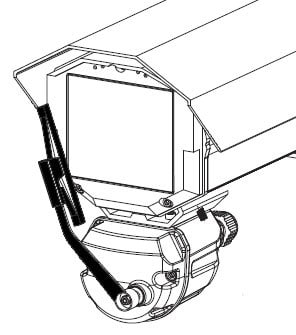Hardware features
Embedded Karabin camera is an industrial system for serious traffic applications in completely operational situations. So, in the process of selecting hardware and implementation of production methods, it is tried to choose the most appropriate components and produce this system through precise and principled approaches. These efforts and precisions have led to achieving the ![]() (Certificate of Europe) standard and also technical capability certificate of Iran’s Industrial research organization.
(Certificate of Europe) standard and also technical capability certificate of Iran’s Industrial research organization.
Hundreds of these cameras are installed in different climates of Iran including warm and wet climates (Khuzestan and Bushehr), hot and desert points (Kerman and Yazd) and cold weathers (Hamedan and Kurdistan) in all over the country and they are still active operationally.
Power issues
One of the most important advantages of the embedded technology is the reduction of energy consumption, which had lead us to new options as electrical power sources for the embedded LPR camera. This, in turn, has significantly decreased the lead time of ITS projects and also facilitates providing the infrastructures. Of course, it should not be forgotten that this method is very friendly to the environment!!! The electrical consumption of the Embedded Karabin camera with color and infrared cameras, white and infrared interior illuminators, electronic controller and processor boards, and power supply circuits is practically less than 25W.
A wide range of 18-72(V) has been considered as the input voltage for the Embedded ANPR camera; which provides the following capabilities:
Power over ethernet
The Karabin embedded cameras are designed compliant with the (IEEE-802.3at PoE +) and (UPOE) standards, so the system’s cabling is greatly facilitated. In other words, to use a Karabin camera, only a single wire is needed, through which both the information and the electricity are transmitted.

Battery usage
Since the input voltage range for the Karabin embedded ANPR camera is wide, the battery can be used easily at the lowest cost as a backup power source. Therefore, by paralleling the battery and ANPR camera power, use the backup battery, when no electricity is available. And due to the low power consumption of the system, it will keep working even in low electrical currents like 18 Volt. Consequently, the battery is used in an optimized way and the upper limit of the input voltage, guarantees the protection of Karabin embedded ANPR camera in charging mode of the battery.
It should be noted that due to the low power consumption of the system, an appropriate power source can be provided for the system for many hours, with a small simple battery.

Solar energy:
One of the advantages of reducing power consumption in Karabin embedded ANPR camera is solar energy being an available option as a power source which makes it possible to use the system in sites where providing electric infrastructure comes at a high price or it is difficult. In this way, by effectively overcoming the biggest bottleneck of ITS projects, we can utilize such systems wherever they are required. Considering the wide range of systems that are based on the Karabin embedded camera, makes this subject more fundamental. It is noteworthy that the minimum mobile communications network in most of the routes and more powerful WiMAX networks in the cities are provided in present time. Thus by solving the problem of power supply in the middle of highways or intercity roads, no other significant infrastructure issue limits the contractor for using the Karabin embedded camera.

Illuminator and imaging
There are 3 different illuminators in the embedded Karabin camera, each of which has its own function. For ANPR camera lighting, the 850nm infrared illuminator with a power of 200 watts has been embedded, which in practice, its Luminous Flux (the measure of the perceived power of light) is 20,000 mW. All the projectors are controlled by PWM; therefore, their effective power consumption is extremely low.
To illuminate the license plates at night and to provide a clear picture of license plates at all hours of the day, a few LEDs with white light are also embedded in the Karabin. Although acting in pulse mode, this internal illuminator is still visible to human eye persistently.
In addition to the interior illuminators, an external illuminator is mounted on the lighting pole, alongside the Karabin, which is tasked with illuminating the scene in order to provide the proper color picture of the vehicle’s body all day long. This illuminator is also designed using LED modules and it is controlled by Karabin’s electronic boards by a square wave generated. Three operating modes have been implemented for the exterior illuminator:
- Pulse mode:
In this case, the light of the illuminator seems continuous and mild. The system provides unnoticeably color images for all the vehicles at sight.
- Flash mode:
The illuminator is normally off, but when a violation occurs it will be turned on for a moment with an intense glow. In this way, in addition to providing a suitable color image of the vehicle, the offender driver will be punished too.
- Concurrent mode:
Usually, when everything is normal, the illuminator acts in pulse mode. But for violation cases, it lights the scene as if it is in flash mode. Also in this case, besides that color pictures are taken from cars, offending drivers are punished.
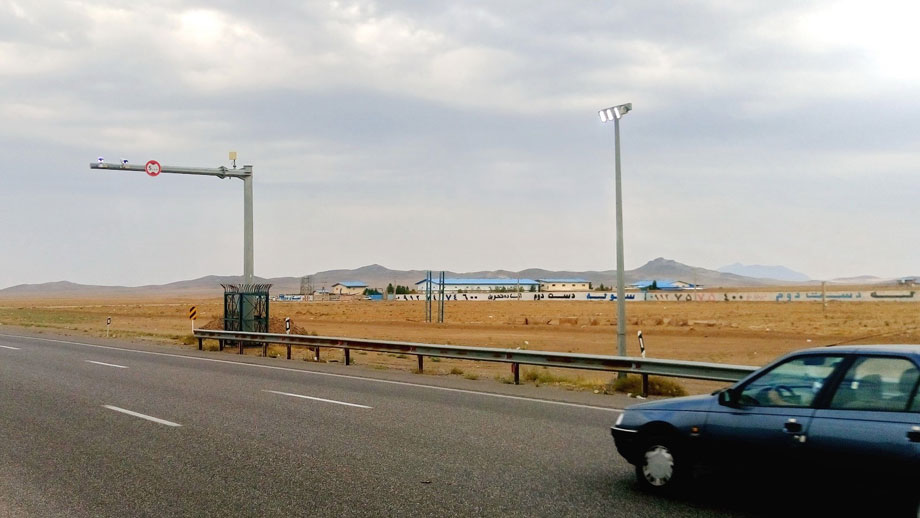
Environmental protection
The housing and body of the embedded Karabin ANPR system meet the highest standards of environmental protection such that ensures the reliability of the system’s proper functioning over time in a variety of environmental conditions. IP66 is the IP code assigned to it which means that dust cannot penetrate to it and also it can resist water jet pressure in any direction.
IP | First number (Solid protection) | Second number |
0 | Lack of protection | Lack of protection |
1 | Protected against external solid objects up to 50 mm, such as hands or large appliances | Protected against dripping of vertical water droplets |
2 | Protected against external solid objects up to 12.5 mm, such as a finger or a piece of large equipment | Reserved against dripping water droplets if the container is 15 ° in any direction bent relative to the perpendicular |
3 | Protected against external solid objects up to 2.5 mm, such as cable or small tools | Resistance to water spray from any direction to 60-degree angle |
4 | Protected against external solid objects up to 1 mm, like wire or screw | Resistance to water spray in any direction |
5 | Relative resistance to dust entering, but the dust does not cause harmful damage | Resistance to low-pressure water jet in any direction |
6 | Anti-dust (dust cannot/ enter) | Resistance to high-pressure water jet in any direction |
7 | – | Short-term immersion is allowed |
| – | Permanent drowning is allowed |
In addition to protecting the system from environmental dangers, a sun shield has been considered in order to protect the system against direct sunlight. The body of the camera is made of extruded aluminum, which makes the system damage proof. To maintain the proper appearance of the system over time, the body is painted with epoxy-polyester electrostatic paint and all the screws are selected from stainless steel. Appropriate cable glands are also used as interface cables.
In terms of temperature, all electronic equipment and boards in the embedded Karabin ANPR camera have been produced under standards which make it possible to operate in a temperature range of 30-60 without any problems.
Easy setup
Being easy to install is one of the most important reasons for the increasing use of all in one system.
Traffic control systems or traditional violation detection cameras have multiple and discrete components that installing and coordinating them is time-consuming and costly for the final proper performance. But a well-designed Embedded camera just needs the fundamental infrastructures and then the whole system functioning is done by the All in one camera. For easy installation of Karabin embedded camera, the following factors are considered in the design:
Interface cable management
In order to connect the Karabin camera to the power supply, communication network and electronic inputs and outputs etc., two or three terminal junction glands are considered at the end of it. In order to facilitate wiring and installation of the system, two options for cable management have been designed.
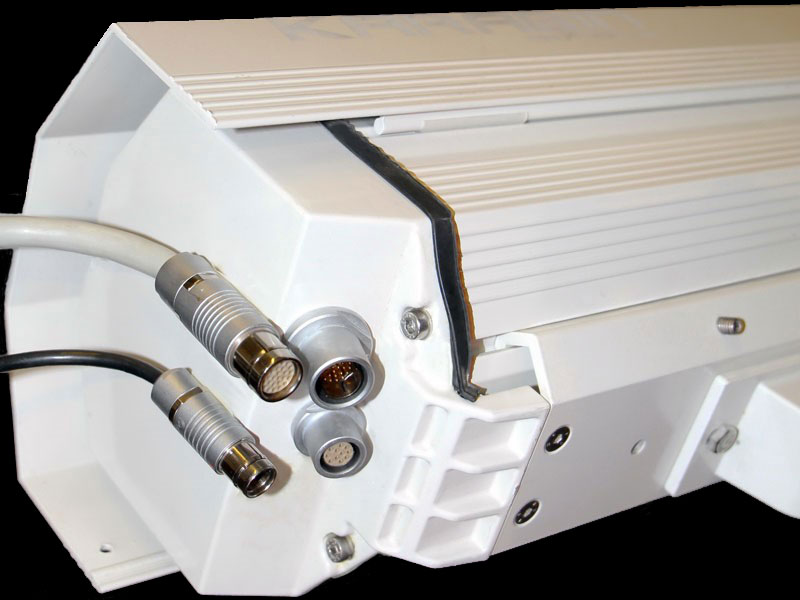
The second solution is to use cable managing box and signal division electronic boards, which output Karabin cables are directly connected to this box. Waterproof standard network connectors and the other connections for connecting the camera to the external environment are considered in this box.
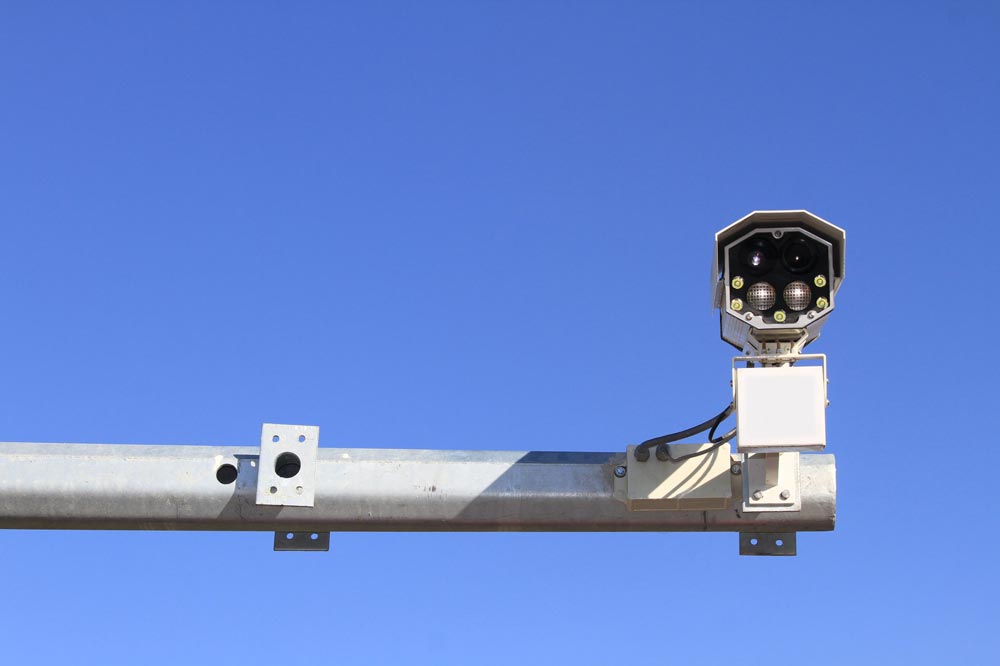
This solution provides another achievement which is implemented on this board, protection and separation elements. So if any problem occurs in wirings and connections, these fuses and smithereens protect the Karabin, before damaging the internal components.
Power and network infrastructure
Using the Embedded hardware, the Karabin camera has very low power consumption (less than 25 watts) and has a range of input voltages varying from 18 to 72 volts. Thus providing Energy for this system is possible by means of sources with the least power such as solar panels or POE. Also, due to compression algorithms for images and traffic, produced data can be easily transmitted to the monitoring center and the central server using low-bandwidth networks, including cellular-based networks. Therefore, two basic challenges have been resolved in implementing ITS projects for the contractors and employers in this field.
User-friendly customization and calibration
Karabin system does not require any special calibration for ANPR and the functionality is possible right after installation. But in order to speedometer application and improve the overall accuracy a calibration mechanism has been considered. The system can easily be calibrated by taking some reference pictures and extracting the camera parameters. Also, for general system settings such as IP, name and address etc. a technician with the least knowledge of network and the subject will be able to easily set up the system through a user-friendly Web-based graphical user interface.
Pole
Traditionally, LPR cameras are installed on L-shaped poles on the streets or roads. Naturally, we will have less overlap and better images in this way. However, in terms of processing, by considering the preprocessing module provided in the processing engine of the Karabin camera, eliminating perspective effect and reading plates in acute angles will also be possible. Thus, the built-in Karabin can be mounted on poles other than L-shaped ones or on the wall and other equipment in the streets and roads.
A standard pole special for traffic applications has been designed and it is offered to employers and contractors with a complete map. All cables pass through inner space of the pole in this design. Extra space has been considered on top of it in order to install accessories such as a battery, switches, etc. This eliminates the need for ground mount outdoor enclosure or box on the pole.
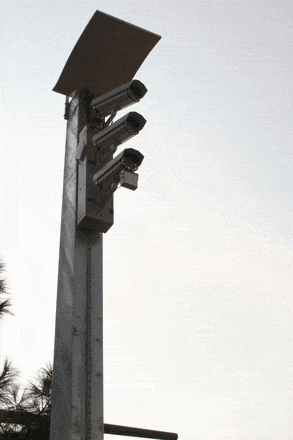
Electronic control unit
In addition to processing tasks and the function of recording traffic and violations, the Internal electronic circuits of the Karabin embedded ANPR camera, also has the duty of monitoring the sensors and controlling the internal state of the system, which takes place in the electronic control unit of Karabin. Below are some important duties which this unit is responsible for:
Multi-layer watch dog
An ITS equipment like Embedded Karabin camera may be installed on distant places so the availability to them might be difficult and cost too much, therefore it is obvious that this system should be automatic so it can overcome this kind of unpredicted problems. Accordingly, a multi-layer protecting mechanism is predicted for the system which can reform the system after these problems. Watch Dog, a layer of this mechanism, is a kind of hardware which attempts to overcome the issue by operations like hardware reset, in such cases.
Electronic I/O
Several GPIOs (General Purpose Input/Output) are considered for the system. Two of them are digital input (receiving data) and four of them are digital output (generating output signals). GPIOs are used to transfer data in cases such as:
- Traffic light status signal needed for red-light violation enforcement systems
- Security Alarm functionality
- Connection to barricades in order to control them and receiving status from sensors
- Connection to magnetic loops
- Receiving signals from any key, micro-switch or optical sensor
- Turning on and off the lights, projectors, sirens or Traffic lights
- Generating the signal needed to activate the “Preset” system for surveillance controlling cameras
All of these inputs and outputs are electrically isolated so that the connection problems and even unwanted voltages do not damage the delicate internal circuitry of the camera.
Temperature sensors
There are three temperature sensor designed for each Karabin embedded ANPR camera to monitor the temperature of the various parts, allowing the user to control different parts of the final system based on these measurements. One of these sensors is inside the Karabin, measuring its internal temperature. The other two are placed outside of it to measure air and the external equipment box temperature. All temperature measurements are recorded in the system for further reference.
Models
In fact, Karabin is a platform which can be changed if it is required. Generally, the model of Karabin is determined by its application. So three types of Karabin can be defined based on its general functionality:
- Radar Karabin as an LPR and speedometer camera
- Red light violation enforcement Karabin (passage or stop on the crosswalk)
- Traffic record Karabin (LPR and LPR)
The other factor which is a characteristic of Karabin is the number of covering lines. Usually, Karabin is supplied with two lines coverage and in order to cover more lines, two Karabins would be applied. So two Karabins with a Radar should be applied in order to cover a four-lane road.
But due to low width paths, one line Karabin is also supplied for Traffic record Karabin, which is more economical and for Access control function, the model of Karabin which is without color-camera, is supplied.
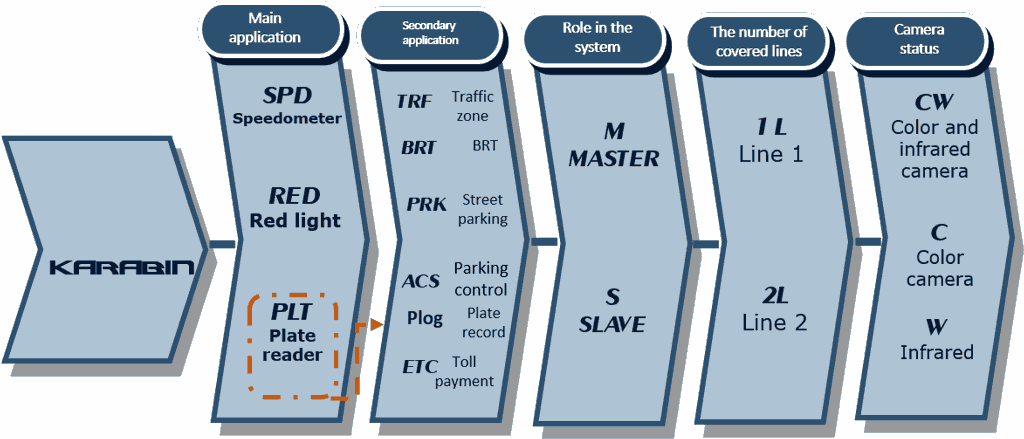
For example, KARABIN-RED-M-2L-CW camera is 2-line system for red light violation enforcement which contains color camera and infra-red LPR camera. It is worth mentioning that according to law, color camera is necessary for all the LPR systems.
Or as another example, KARABIN-SPD-M-2-L-CW camera, is a 4-line camera which is connected to a radar and it shares the radar data with KARABIN- SPD-M-2-L-CW camera which is not connected to the radar. These two cameras together define a 4-line speedometer radar Karabin.
Discontinued models
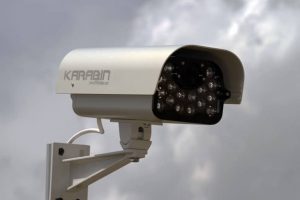
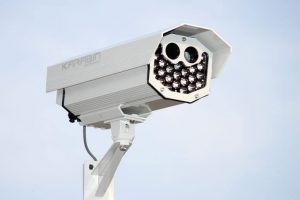
Due to the fact that all stages of hardware and system design of the Karabin embedded camera have been done by the company’s experts, it is possible to change the hardware features and easily produce custom ones. For example, it is possible to increase the system’s camera resolution up to 12MP. Also camera’s frame rate can be raised up to more than 200 frames per second in Full HD cameras.
Accessories
To enhance the efficiency and in order to add new features to the Karabin embedded ANPR camera various Accessories have been designed as follows:
GPS
By adding this accessory, it would be possible to set the exact time for system and also extract the system’s location. Time setting is automatically done in the system according to the rule of “Daylight saving time” in summer. Thus, space or time information presented with each output photo is completely accurate and valid.

Wi-Fi
Adding the Wi-Fi network module to the Karabin embedded ANPR camera makes local access to the system easy. So for local device deployment or remote access to its settings, it would be possible to perform them without the need for a wired connection to the camera (which may be out of reach).

Communication equipment
In many ITS projects, the network infrastructure is created through optical fiber cable or radio communications, in which connection between the Karabin embedded ANPR camera and the network is established via Ethernet; but the introduced method is costly and difficult in some projects. In these cases, cellular based wireless networks, including GPRS, 3G, EDGE, 4G and WiMAX can be used. Therefore, by using solar energy to overcome power supply problem and cellular networks (which nowadays not only are available in cities but also in most of the roads) to solve communication obstacles, power supply and communication problems are solved and it appears that no other barrier is on the way to use ITS projects and have smart roads.
Input/output development board
A network electronic board with an Ethernet communication interface is designed alongside the Karabin camera, which can be used in situations such as:
- where we need to control more inputs and outputs
- when input and output signals are applied and received somewhere considerably far from the camera installation location
- When we intend to communicate wirelessly from the point of action of the signals to the Karabin camera
This board is able to receive input and apply output signals in a protected way and communications used to manage this process are established through a network-based platform. All inputs and outputs of this board are electrically isolated. The outputs can be set in two ways: voltage level or relay stimulation. Inputs can also be set to voltage-sensitive or switch mode.
Extra hard disk
32GB of SSD memory by default is considered in the Karabin embedded ANPR camera in order to store data and images, which can be upgraded to 1TB to increase the possible amount of traffic and violation data stored in it.
Wiper
Considering the purposes of the embedded system, one of which is being installed and maintained with the least effort, the essentiality of an auto-cleaner system becomes more justified. Therefore, in addition to the possibility of using nanotechnology-based solutions, self-cleaning of the front camera window can also be done using special wiper.
